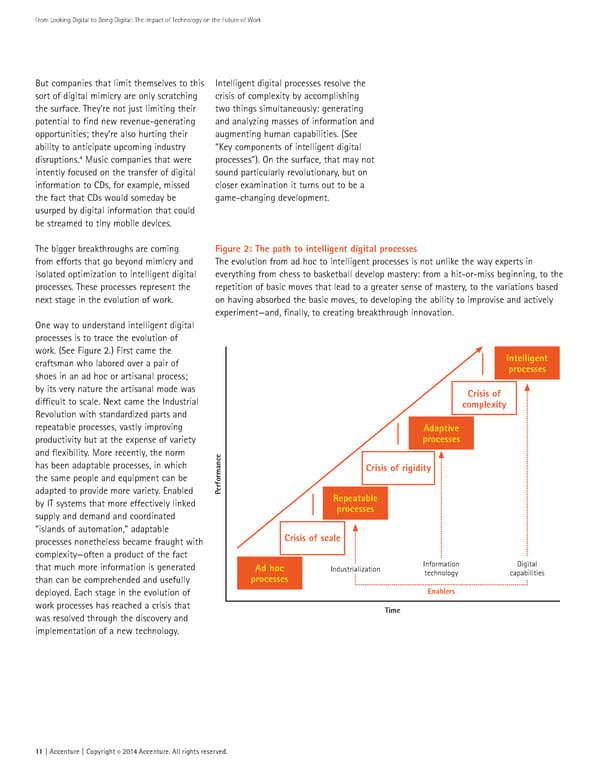From Looking Digital to Being Digital: The Impact of Technology on the Future of Work But companies that limit themselves to this Intelligent digital processes resolve the sort of digital mimicry are only scratching crisis of complexity by accomplishing the surface. They’re not just limiting their two things simultaneously: generating potential to find new revenue-generating and analyzing masses of information and opportunities; they’re also hurting their augmenting human capabilities. (See ability to anticipate upcoming industry “Key components of intelligent digital 4 disruptions. Music companies that were processes”). On the surface, that may not intently focused on the transfer of digital sound particularly revolutionary, but on information to CDs, for example, missed closer examination it turns out to be a the fact that CDs would someday be game-changing development. usurped by digital information that could be streamed to tiny mobile devices. The bigger breakthroughs are coming Figure 2: The path to intelligent digital processes from efforts that go beyond mimicry and The evolution from ad hoc to intelligent processes is not unlike the way experts in isolated optimization to intelligent digital everything from chess to basketball develop mastery: from a hit-or-miss beginning, to the processes. These processes represent the repetition of basic moves that lead to a greater sense of mastery, to the variations based next stage in the evolution of work. on having absorbed the basic moves, to developing the ability to improvise and actively experiment—and, finally, to creating breakthrough innovation. One way to understand intelligent digital processes is to trace the evolution of work. (See Figure 2.) First came the Intelligent craftsman who labored over a pair of processes shoes in an ad hoc or artisanal process; by its very nature the artisanal mode was Crisis of difficult to scale. Next came the Industrial complexity Revolution with standardized parts and repeatable processes, vastly improving Adaptive productivity but at the expense of variety processes and flexibility. More recently, the norm has been adaptable processes, in which Crisis of rigidity the same people and equipment can be adapted to provide more variety. Enabled erformance P Repeatable by IT systems that more effectively linked processes supply and demand and coordinated “islands of automation,” adaptable processes nonetheless became fraught with Crisis of scale complexity—often a product of the fact that much more information is generated Ad hoc Industrialization Information Digital than can be comprehended and usefully processes technology capabilities deployed. Each stage in the evolution of Enablers work processes has reached a crisis that Time was resolved through the discovery and implementation of a new technology. 11 | Accenture | Copyright 2014 Accenture. All rights reserved. ©
 From Looking Digital to Being Digital Page 9 Page 11
From Looking Digital to Being Digital Page 9 Page 11